“Revolutionary Nvidia GPUs: RTX 3000 & 4000 Series Unveil Multi-Frame Generation Power!”
Dreams Can Become Real – Introduction.

In watch a recent Video by REDGAMINGTECH who there with the latest tech news is always highlighted something no one else has been taking about. The incredible possibility that NVIDIA RTX 3000/4000 GPUs could soon deliver Multi Frame Generation Technology from driver update. Exciting as this sounds it appears it’s a possibility but not yet confirmed it will happen! If you would like to see REDGAMINGTECH video, it’s linked at the bottom of this post.
NVIDIA’s Bryan Catanzaro, Vice President of Applied Deep Learning Research
NVIDIA’s Bryan Catanzaro, Vice President of Applied Deep Learning Research, has discussed the potential for extending Multi Frame Generation (MFG) technology to previous GPU generations.In a recent interview, he emphasized that while MFG is launching with the RTX 50 Series, the company is exploring optimization strategies to possibly adapt this technology for older hardware, including the RTX 40 Series. However, Catanzaro noted that he cannot promise anything specific at this time.
The feasibility of implementing MFG on earlier GPUs hinges on several factors:
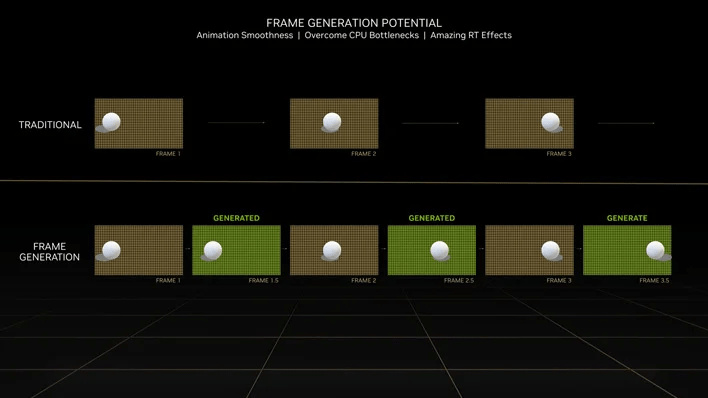
- Hardware Requirements: The new frame generation algorithm is significantly more Tensor Core-intensive, which may present challenges for GPUs with fewer Tensor Cores.
- Optimization and Engineering: Adapting MFG to older hardware involves substantial optimization efforts to ensure acceptable performance and image quality.
- User Experience: Delivering a seamless and high-quality user experience is paramount, and any adaptation must meet NVIDIA’s standards for performance and visual fidelity.
As of now, NVIDIA has not committed to bringing MFG to the RTX 3000 or 4000 series GPUs but are testing it would seem from the full interview that I have now watched. The company is currently focused on optimizing this technology for the RTX 50 Series and will assess the potential for backporting it to earlier models in the future.

Multi-Frame Generation: What It Is and How It Works
Multi-frame generation is a cutting-edge technology aimed at improving gaming performance by generating additional frames per second (FPS) without relying solely on the hardware’s raw rendering power. The process uses advanced machine learning (ML) techniques, where an AI model predicts intermediate frames based on the data from preceding and succeeding frames. This prediction helps to effectively “fill in the gaps,” allowing for smoother visuals without requiring significant computational power from the GPU.
The big step with Multi Frame Generation as opposed to the previous model is its wholly tensor core based with the new version and a much different graphical pipeline in its creation. Previous versions also relied on the GPU to do some of the work but that’s now changed. With RTX 3000 & 4000 cards having tensor cores it may now be an opportunity to expand the MFG option to these cards as well.

Advantages and Challenges of Multi Frame Generation
- Smoother Gameplay: Multi-frame generation enhances the fluidity of motion in games, making for a more immersive experience.
- Reduced GPU Workload: By generating frames artificially, the GPU can handle higher resolutions or graphical fidelity without compromising performance.
- Latency Concerns: In competitive gaming, latency—the delay between a player’s input and the resulting on-screen action—is crucial. While multi-frame generation improves FPS, the interpolation process can introduce minor delays. NVIDIA’s technologies like Reflex (discussed below) are designed to counteract these effects by optimizing the rendering pipeline and reducing input lag.
One of the big issues is the talk of excessive lag in this desire to increase frame rates using Multi Frame Generation. Nvidia’s Bryan Catanzaro, Vice President of Applied Deep Learning Research explained that the additional frames do not take the same time to generate as the previous single frame in the old version on RTX 4000 CPU’s. The example below shows NVIDIA’S reported FPS and Latency Times.
As always, a third-party reviewer is a great place to confirm these figures because Nvidia and AMD do often cherry pick games that support to ring the bell of success! The graphic shows minimal extra time regardless of the additional frames being generated and displayed.
DLSS: Deep Learning Super Sampling
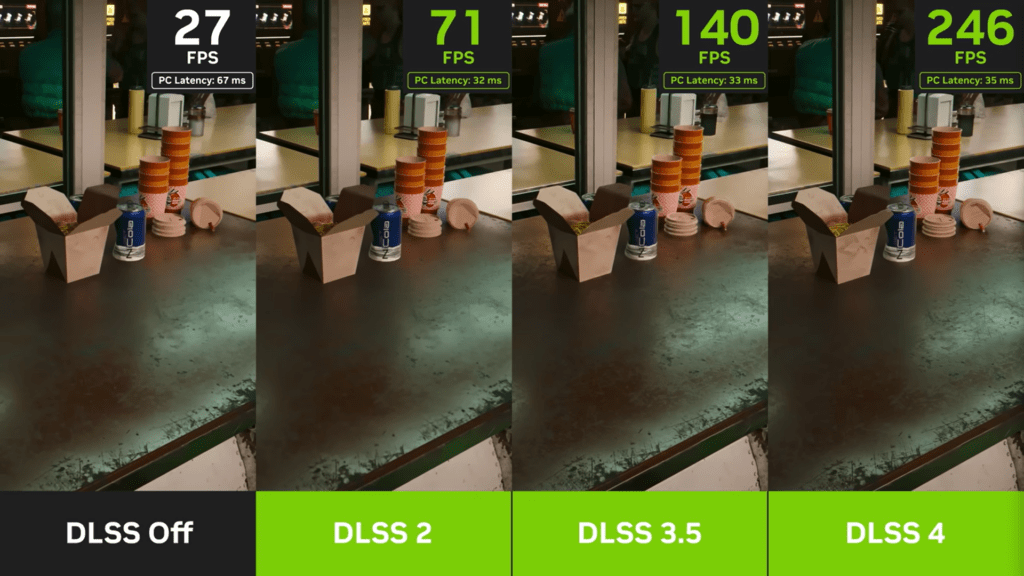
DLSS is a separate but complementary NVIDIA technology. It uses AI to upscale lower-resolution images to higher resolutions while maintaining visual fidelity. For example, a game might internally render at 1080p but appear nearly identical to a native 4K resolution, thanks to DLSS’s intelligent reconstruction. It’s awesome technology with AI assisting to make it better quality all the time.
This technology is especially beneficial in graphically demanding scenarios like flight simulators, where rendering at high resolutions with detailed environments can be taxing. DLSS helps maintain high FPS without significant sacrifices in image quality.
NVIDIA Reflex: Minimizing Latency
Reflex is NVIDIA’s solution for reducing system latency. It streamlines the communication between the CPU and GPU, ensuring that frames are rendered and displayed as quickly as possible. This is particularly valuable for competitive gamers, where every millisecond counts.
Ray Tracing: Realistic Lighting and Shadows
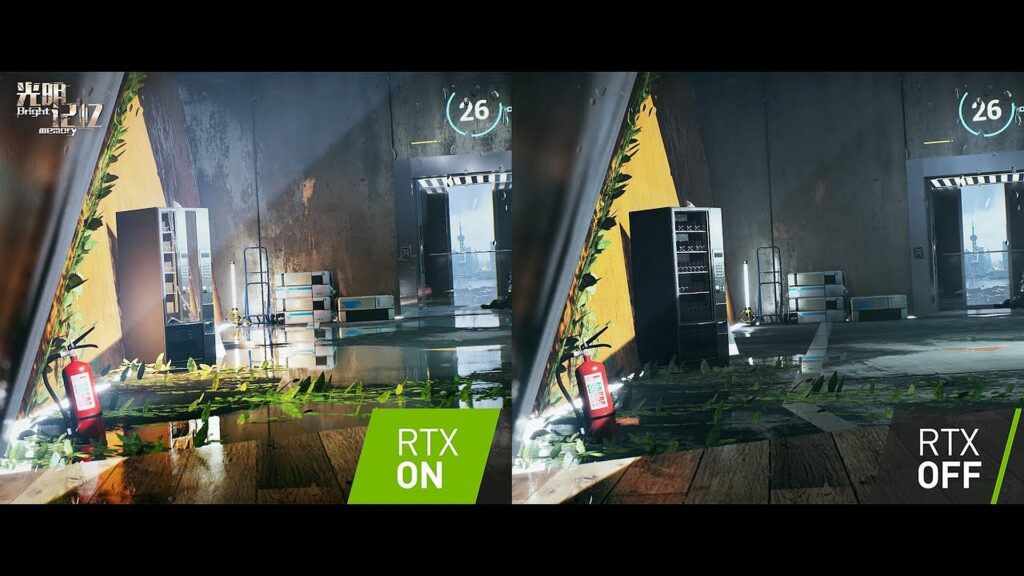
Ray tracing simulates the way light interacts with objects in a scene, producing realistic reflections, shadows, and global illumination. While it significantly enhances visual realism, ray tracing is computationally expensive. DLSS and, potentially, multi-frame generation, help mitigate the performance impact of enabling ray tracing in games.
This is only important if your flight sim of choice has these options. DCS and MSFS do support DLSS and possibly MFG on the right hardware. X PLane 12 on Vulcan is yet to be able to accommodate DLSS with the engine needing what are serious additions adding Vector Information for DLSS to work.
Let’s hope it happens but it maybe X Plane 13 before that’s even possible, so raw rasterization is the focus even though XP12 although having older FSR by AMD. The implementation of FSR seems very poor and pretty unusable in XP12 so let’s hope the latest version of FSR 3/4 like MFG has been made solely tensor core based and may then extend to XP12 with older GPU hardware as well.
Resizable BAR Nvidia
The GPU and CPU talk closely together but normally the CPU can only use 256 MB of the GPU memory which is massively faster than RAM. Turning on Resizable BAR allows the CPU to use as much GPU fast memory allowing it to be hugely more efficient. The results depend on game to game but if you’re on a Nvidia 3000 or later GPU turn it on in the BIOS. Here’s a guide to how to do it.
To enable Resizable BAR on an NVIDIA graphics card, there are a few steps you need to follow. Resizable BAR (Base Address Register) works similarly to AMD’s Smart Access Memory (SAM), allowing the CPU to have direct access to the GPU’s memory, which can result in performance improvements in certain games.
Here’s how to enable Resizable BAR for NVIDIA GPUs:

1. Check Hardware Compatibility
- GPU: You need an NVIDIA RTX 30-series (like RTX 3060, 3070, 3080, 3090) or newer GPU.
- CPU: A compatible Intel or AMD processor (Intel 10th gen or newer, or AMD Ryzen 3000 series or newer).
- Motherboard: Your motherboard must support Resizable BAR. Most Z490, Z590, B550, X570, and newer motherboards support it, but you may need to ensure that it is enabled in BIOS.
2. Update Your BIOS
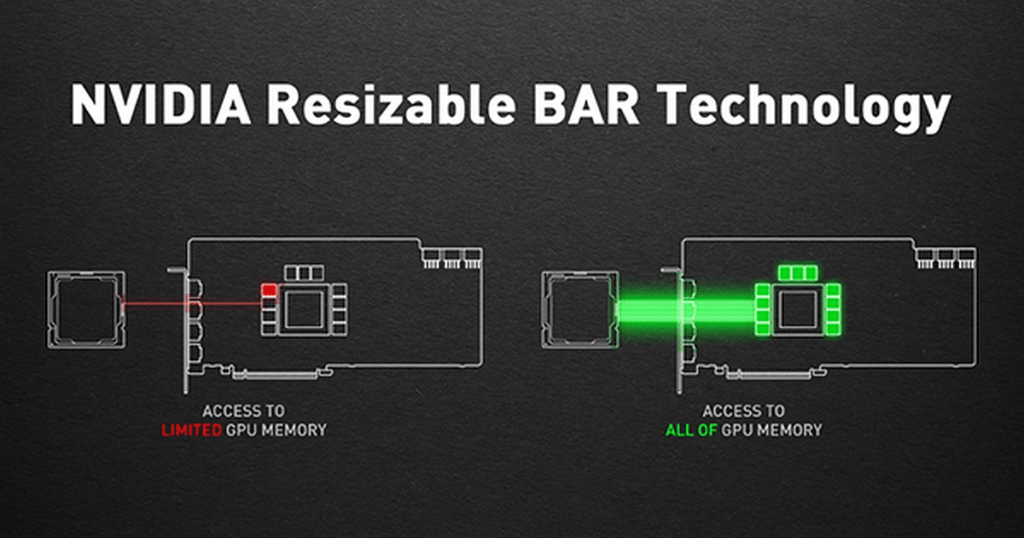
- Check for Resizable BAR support: Visit your motherboard manufacturer’s website and check if there is a BIOS update that adds Resizable BAR support. If an update is available, download and install it. Follow the manufacturer’s instructions to update the BIOS, as improper updates can cause issues.
- Enable Resizable BAR in BIOS: After updating, reboot your PC and go into your BIOS settings. You should look for an option related to Resizable BAR or Re-Size BAR Support. Make sure it’s enabled.
3. Update Your NVIDIA Graphics Drivers
- Ensure you have the latest NVIDIA driver. Resizable BAR support is included in NVIDIA’s driver version 465.89 and newer.
- Download and install the latest driver from the NVIDIA website.
- Alternatively, you can update through the GeForce Experience app.
4. Enable Resizable BAR in NVIDIA Control Panel (if needed)
- Open the NVIDIA Control Panel (right-click on your desktop and select NVIDIA Control Panel).
- Under the System Information tab, check if Resizable BAR is listed as Supported. If it shows “Supported,” it means Resizable BAR is enabled.
- In case it’s not automatically enabled, look for a setting that may allow you to toggle it (this might not be required if your system and drivers are up to date).
5. Verify Resizable BAR is Enabled
- After everything is set up, you can check if Resizable BAR is enabled by using NVIDIA’s GPU-Z or similar tools.
- In GPU-Z, go to the “Advanced” tab, and check for Resizable BAR under the “PCIe” section.
- You can also verify by checking if Resizable BAR is listed as Enabled in the NVIDIA Control Panel.
6. Testing
- Once Resizable BAR is enabled, you can benchmark or play games that support it to see if there’s a noticeable performance increase.
- Games like Cyberpunk 2077, Watch Dogs: Legion, and Shadow of the Tomb Raider benefit from Resizable BAR.
Let me know if you run into any issues during this process!
AMD Radeon Technologies
AMD offers a robust suite of features to rival NVIDIA’s innovations. Here’s a breakdown of their current and upcoming technologies in an attempt not to be totally NVIDIA focused as AMD Radeon have some great tech as well on their side especially with rasterization as many games do not support the full NVIDIA suite of extras such as “Multi Frame Generation”.
It’s worth noting that X Plane 12 has FSR available but no other technologies from NVIDIA such as DLSS etc. Conversely MSFS 2024/2024 has a majority of NVIDIA features available depending on what Nvidia card you have. DCS World supports DLSS which is great but not seen mention of any MFG being available but if you have a 4000 series card and it is please let me know in the comments.
FSR 3: FidelityFX Super Resolution
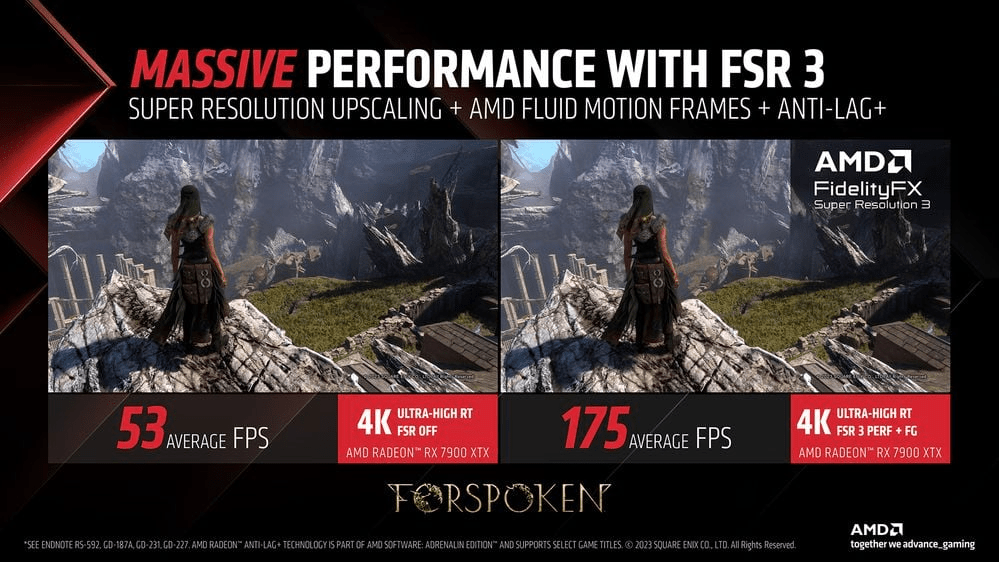
FSR 3 is AMD’s upscaling solution, analogous to NVIDIA’s DLSS. The latest iteration introduces frame generation, allowing AMD GPUs to achieve smoother performance by generating interpolated frames. Unlike DLSS, which leverages proprietary AI hardware like Tensor Cores, FSR is designed to work across a broader range of hardware, including older AMD GPUs and even NVIDIA cards.
X Plane 12 FSR implementation
As of the latest updates, X-Plane 12 uses AMD FSR 2.1 (FidelityFX Super Resolution). This version provides improved image quality and performance over the previous iterations, with better upscaling algorithms and reduced artifacts.
If you’re using FSR in X-Plane 12, you should be able to enable it in the graphics settings to improve performance, especially if you’re playing at higher resolutions. Are you currently using FSR in your setup, or are you looking into enabling it?
My experience has been poor unfortunately with FSR 2.1, but you may have had a better experience with it. Maybe the latest version may be included at some time in the near future.
Smart Access Memory (SAM)

SAM enables AMD Ryzen CPUs to access the full memory pool of Radeon GPUs, reducing bottlenecks and improving performance. This feature is particularly effective in scenarios where data transfer between the CPU and GPU can be a limiting factor.
Enabling SAM (Smart Access Memory) on your PC requires a few steps to ensure that both your hardware and software are properly configured. SAM allows your AMD Ryzen 5000-series or 3000-series CPU (with a compatible motherboard) to access the full VRAM of your AMD Radeon GPU, potentially improving performance in supported games.
Here’s how you can enable SAM:
1. Check Your Hardware Compatibility
- CPU: You need an AMD Ryzen 3000 (with a 5000-series CPU recommended) or later processor.
- GPU: An AMD Radeon RX 6000-series GPU or later.
- Motherboard: You’ll need a compatible AMD 500-series motherboard (B550, X570) with the BIOS update for SAM support.
- RAM: Make sure your system has UEFI mode enabled.
2. Update Your BIOS
- Visit the motherboard manufacturer’s website and download the latest BIOS version that supports Resizable BAR (which is required for SAM).
- Flash the BIOS using your motherboard’s BIOS update utility. Follow the manufacturer’s instructions carefully to avoid any issues.
3. Update Your Graphics Drivers
- Ensure that you have the latest AMD Radeon drivers installed. SAM is supported in the Adrenalin 21.10.4 driver and later.
- You can download the latest drivers from the AMD website.
4. Enable SAM in BIOS/UEFI
- Reboot your PC and enter the BIOS/UEFI settings by pressing the appropriate key (usually Delete or F2) during boot.
- In the BIOS settings, navigate to the Advanced or Chipset menu.
- Look for an option labeled Resizable BAR or Smart Access Memory (it may be listed under a setting like PCI Subsystem Settings).
- Enable Resizable BAR or Smart Access Memory (if it’s not already enabled).
5. Enable SAM in AMD Radeon Software
- Open AMD Radeon Software (right-click the desktop and select AMD Radeon Software).
- Go to the Settings (gear icon) in the top right.
- Under the Graphics tab, scroll down and enable the Smart Access Memory toggle.
- It may require a system reboot for the changes to take effect.
6. Verify SAM is Enabled
- Once you’ve rebooted your PC, you can check if SAM is working by going to AMD Radeon Software and looking for the SAM status in the performance metrics section. You should see a message indicating that Smart Access Memory is enabled.
Once completed, SAM should be active, allowing your system to take advantage of the additional memory bandwidth between the CPU and GPU. This can lead to improved gaming performance, especially in certain titles that support it.
Let me know if you run into any issues during the process!
Radeon Anti-Lag
This is AMD’s counterpart to NVIDIA Reflex, designed to reduce input latency. It ensures that frames are delivered to the screen as quickly as possible, providing a competitive edge for gamers.
Radeon Super Resolution (RSR)

RSR is a spatial upscaling feature built into AMD’s drivers. Unlike FSR, which requires game-specific integration, RSR works at the driver level and can be applied to virtually any game. While not as sophisticated as FSR, it offers a convenient way to improve performance on a broader range of titles.
RDNA 3 and Upcoming RDNA 4 Architecture
AMD’s RDNA 3 architecture powers the current generation of Radeon GPUs, offering significant improvements in power efficiency and ray tracing performance. The upcoming RDNA 4, expected to debut with the Radeon 9070 series in March 2025, promises further enhancements in ray tracing, upscaling, and frame generation technologies, as well as increased efficiency.
Tech Comparison Thoughts.
Both NVIDIA and AMD are pushing the boundaries of gaming technology, offering unique solutions tailored to different needs. NVIDIA’s ecosystem, with technologies like DLSS, Reflex, and ray tracing, excels in delivering a high-end, feature-rich experience. Meanwhile, AMD’s focus on broader compatibility and open standards, as seen with FSR and RSR, provides more accessibility and flexibility.
For flight simulation enthusiasts, NVIDIA’s DLSS and ray tracing can elevate visual fidelity without sacrificing performance. AMD’s SAM and FSR, on the other hand, are excellent choices for those looking to maximize value and compatibility.

What is important to us as gamers and flight sim fanatics is that not all the sims have this technology available. MSFS 2020/2024 has NVIDIA DLSS and other features, but X Plane 11/12 does not have anything to assist us in performance. X Planes integration of AMD FSR honestly is terrible, more honestly unusable but I believe it’s only FSR 1 and if updated we could see better performance with FSR 2 or 3.

The problem with these technologies is the flight sim graphics engines which are old in many cases and although rewritten still don’t have the modern items required for this emerging technology. Again, if we get vector information then DLSS also becomes possible to integrate with multi frame generation as well I suspect. So, X Plane is all about price to performance, so AMD probably wins that one. Extending to DCS World which has DLSS but not frame generation as far as I know being on an RTX 3070 personally, I couldn’t use it anyway still makes Nvidia the choice.
As new generations of GPUs emerge, the competition between NVIDIA and AMD ensures that gamers and developers alike benefit from continuous innovation.
REDGAMINGTECH VIDEO – Click here to watch it. Watch the Digital Foundry Interview Here -13:00 time stamp for the conversation!
Conclusion & Summary of the Original Conversation.
In watching the full original interview with NVIDIA’s Bryan Catanzaro by DigitalFoundry YT Channel who did ask him directly about MFG in the Nvidia 3000 series CPU’s. He said that it was possible!
The reason it is now a possibility is that all the MFG is now solely Tensor Core Based technology which is a change from the previous version. This makes it possible but to what extent we will have to be patient. Bryan said, “It will depend on what we can squeeze out of older hardware”, so they appear to be testing or considering it but focused on the 5000 series atm.
What this means is yes, it’s possible! Are they looking at it? Well, it seems it’s on the table. Will it happen? Who knows, but they are all about adding features and if multi frame generation MFG can be added to older previously unsupported hardware then it’s another boost in the fight with AMD and their more open FSR compatibility.
As always time will tell if this is a storm in a teacup or something genuinely going to happen or not, time as always will tell!
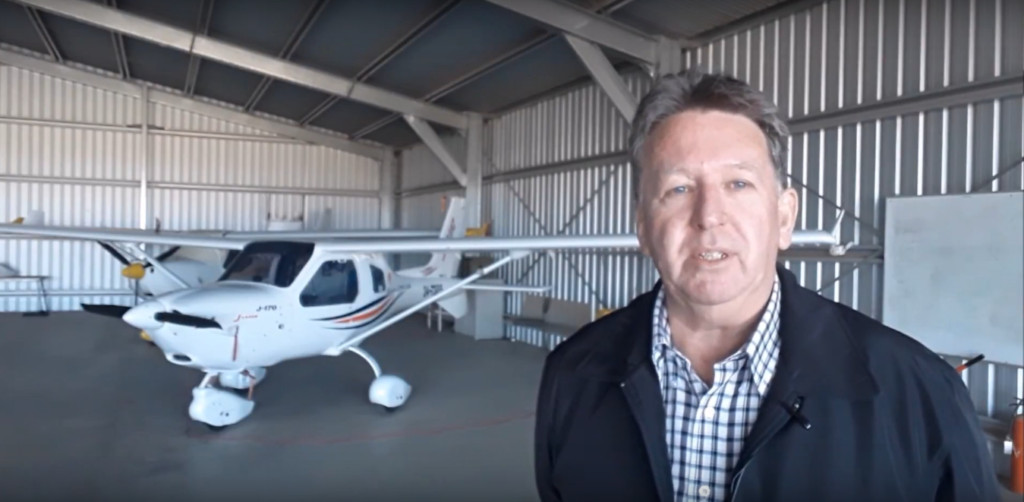
Author
Brendon McAliece (Aka Gunnie) is a military veteran with 23 years working on Jet Fighters, their weapons systems and ejection seat/module systems as well as munitions and R&D. Involved with flight simulation since the 1980s, he has flown all the major flight simulators over the years.
He is an Australian expat who has lived in Malaysia, UK, Saudi Arabia and more recently Thailand. He is a multi-lingual blogger who loves to share his life experiences here on LetsFlyVFR.com and DreamingGuitar.com, with his lifestyle and Travel experiences Blog plus his Dreaming Coffee website.
Learn More @
DreamingGuitar.com – DreamingCoffee.com – LetsFlyVFR.com
(HOME – BLOG – SHOP – ABOUT)
This page has been viewed 0 times.
As an Amazon affiliate I may benefit from qualifying sales.
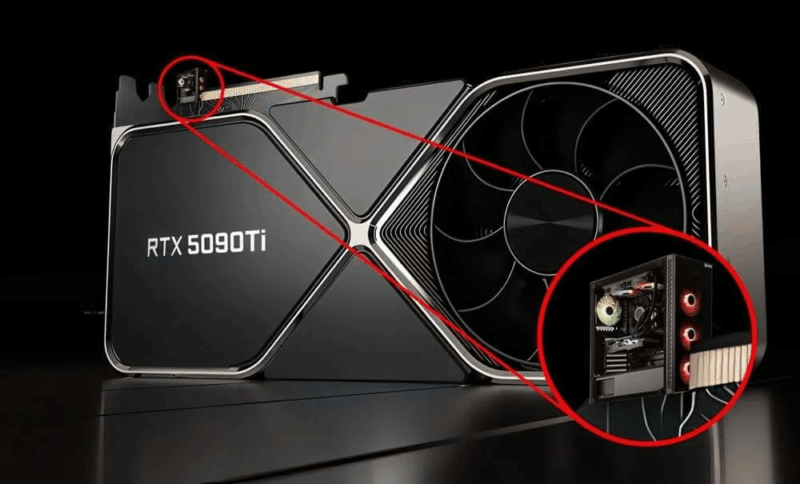
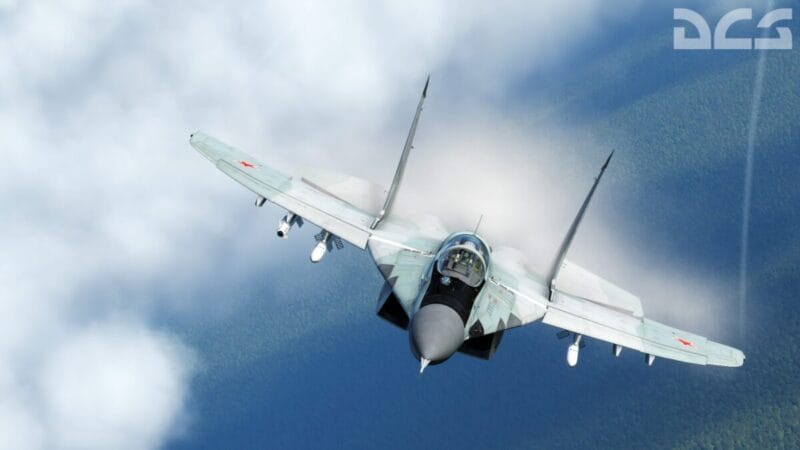



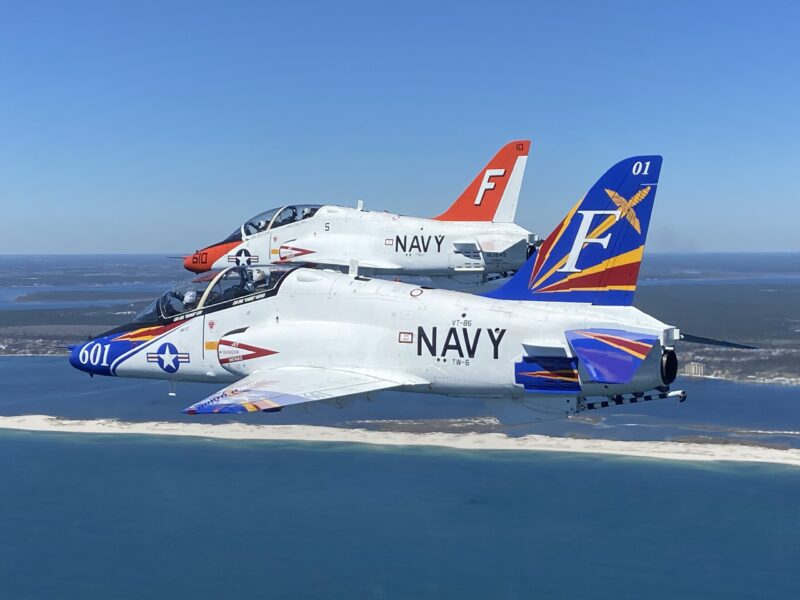




One response to ““Revolutionary Nvidia GPUs: RTX 3000 & 4000 Series Unveil Multi-Frame Generation Power!””